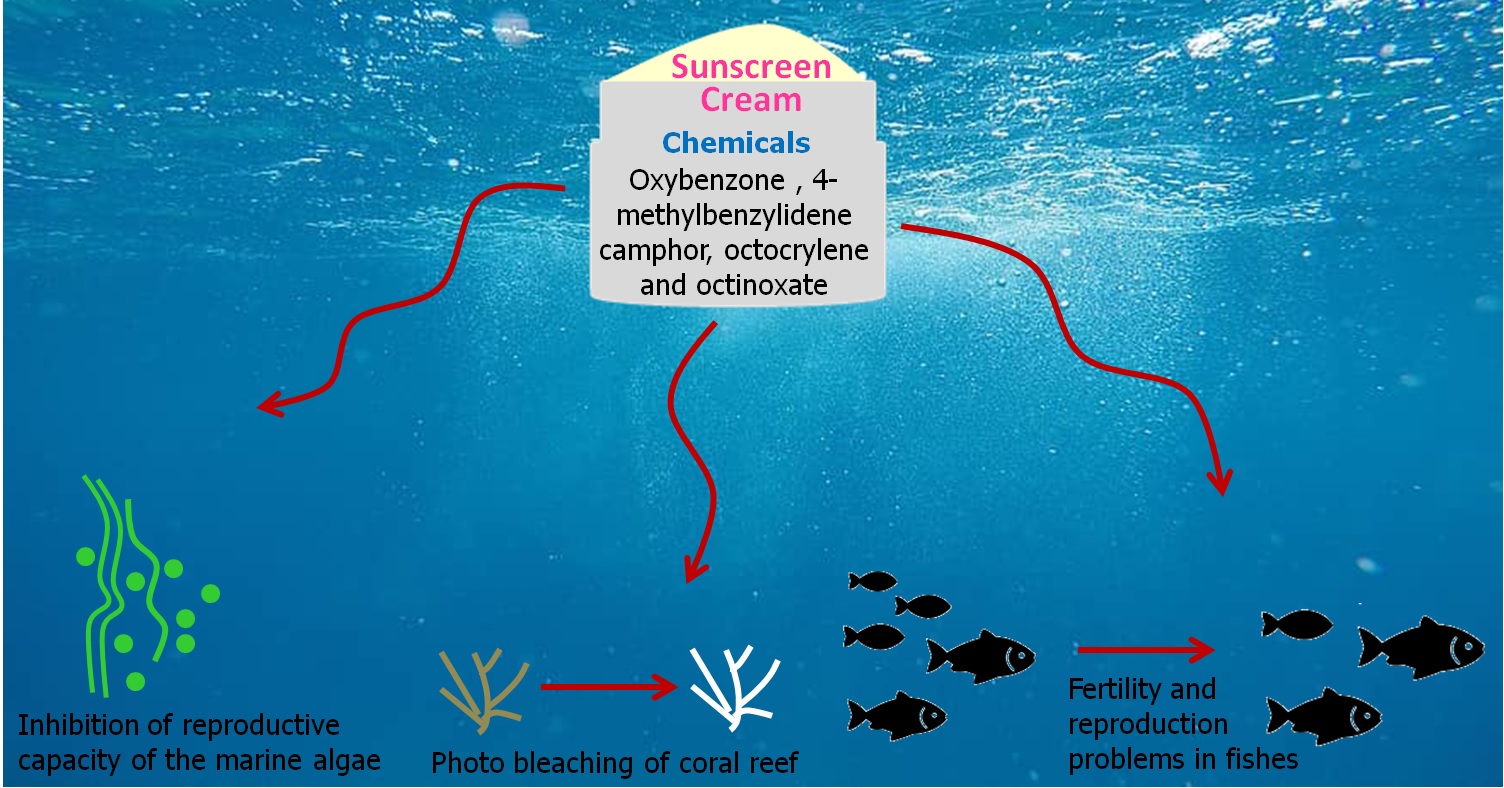The organic ultraviolet filters (UVFs) such as oxybenzone, avobenzone and octocrylene is a major contaminant which can cause effects to the aquatic systems and aquatic habitats. These contaminants are the active ingredients of sunscreen, personal care products and plastic materials. The secondary entry of the UVFs are through the recreational coastal areas. When the users of sunscreen are active in the coastal waters, these UVFs find the way to enter the ocean water via leaching. The UVFs are found to be the emerging contaminants that degrade the aquatic environments. These compounds are used due their stabilization and coaction with the other UVFs. These are majorly used by pharmaceuticals, cosmetics and personal care manufacturing industries in their products to protect the skin of the users against damage from UV-A and UV-B radiation.
UVFs Source and its interaction in aquatic environment
The main source of entry of these UVFs in to the aquatic environment is from the incomplete removal of organic ingredients present in the water which is used for manufacturing process of sunscreens and these effluents released from the waste water treatment plants acts as point sources for the contamination. Most of the sunscreen formulations include insoluble component in order to lengthen the time of adhesion on the skin. Once these insoluble components leach out of the skin the reach the coastal water. Subsequently these chemicals remains stable for a long time in the environment and these started witnessing as emerging pollutants in the different marine environments.
The most commonly found organic UV filters are oxybenzone (benzophenone-3), 4-methylbenzylidene camphor, octocrylene, and octinoxate. They are not only a major constituent of sunscreens but it is also prominent in cosmetics, personal care products and plastic materials. Mediterranean Basin has witnessed the high concentrations of UV filters. In particular the Spain and Greece has high concentrations of UV filters. The researchers at Europe has identified that the concentrations of these UVFs has varied in recreational coastal areas during peaking of users involved in recreational activity.
UVFs and its interaction in aquatic food chain
The UV filters namely benzophenone and its derivatives were identified by few researchers in Europe and they suggested that it is most commonly found in mammals, fish, sea Urchins, Mussels, prawns and clams. The researchers alarm that these compounds can bioaccumulate and biomagnify, and also can cause some potential effects and interactions in the human food chain. They also found that these UV filters in the environment can cause endocrine disrupting effects and toxicity to the animal’s development.
UVFs and its effects on marine species
Several studies have been carried out in Europe, related to the effects of UVFs on different marine species. The results of these studies have evidenced that organic UVFs has effects on marine species and also in marine ecosystem.
Several studies conducted on fish has proved that the UV filters has an important role in impairment of the hormonal control of reproductive processes in fish. In 2014 Bluthgen and co researchers conducted a research on the accumulation of UV filter octocrylene in zebrafish embryos and adult males. They found that this filter modulated mRNA levels of genes involved in developmental and metabolic pathways. The study conducted by European countries has proved that Oxybenzone causes photobleaching in corals and inhibits the reproductive capacity of the marine algae.
In sea turtles’ researchers have identified the presence of UVFs concentrations but specifically the researchers have not attempted to find the role or concentration of each UVFs and its interaction. The results confirmed that the concentrations of UVFs in complex forms as pollutant in the marine environment will have definite effects and will pose different stresses to the wild animals in that multi complex environment. The researches in Daphina magna reveals that the UVFs will cause biological and ecological disruptions to this species at realistic concentrations.
Conclusion
The awareness of protection of the skin against the UV-A and UV-B radiation has increased the usage of sunscreens by the users and that has paved the way for these pollutants in the aquatic environment. Despite of the impact on the marine species, its health and ecosystem, further more studies are required on marine and freshwater environment to integrate the base line data and address the long-term consequences and effects of these pollutants. The recent studies by the European researchers have suggested that UVFs are toxic to different species in marine environment and further more studies are required in identifying the mechanisms of action. The current studies have provided little knowledge on the toxicity of UVFs in marine environment and it is insufficient to assess the potential risk of bioaccumulation of these compounds. It is clear that further studies are required in fresh water environment and species to assess the potential risks of these pollutants in freshwater. Environmental contamination can possess threat to the aquatic organisms and it may require a little time to the aquatic organisms for evolutionary adaptation of these novel toxicants.
